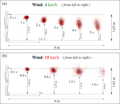Respiratory droplet
Respiratory droplets are the primary means through which respiratory infections, including viruses like the influenza and the SARS-CoV-2 (which causes COVID-19), are transmitted from person to person. Understanding the characteristics and transmission dynamics of respiratory droplets is crucial in controlling the spread of respiratory diseases.
Definition and Characteristics[edit]
Respiratory droplets are generated when an individual coughs, sneezes, talks, or breathes. These droplets can vary significantly in size, from larger droplets that fall to the ground rapidly near the source, to smaller droplet nuclei that can remain suspended in the air for longer periods. The size of these droplets plays a critical role in disease transmission, with droplets larger than 5 to 10 micrometers generally considered to be respiratory droplets, while smaller particles are classified as aerosols.
Transmission[edit]
The primary mode of transmission for many respiratory pathogens is through the inhalation of respiratory droplets containing infectious agents. These droplets can be directly inhaled by individuals in close proximity to an infected person. Transmission can also occur through contact with surfaces contaminated by respiratory droplets, followed by contact with the mouth, nose, or eyes.
Prevention[edit]
Preventive measures to reduce the transmission of respiratory droplets include wearing face masks, practicing good hand hygiene, maintaining physical distance from others, and improving ventilation in indoor spaces. Vaccination may also play a crucial role in preventing the spread of diseases transmitted through respiratory droplets.
Impact on Public Health[edit]
The spread of diseases through respiratory droplets has significant implications for public health, particularly in the context of pandemics such as the COVID-19 pandemic. Understanding the dynamics of respiratory droplet transmission is essential for developing effective public health strategies to control the spread of respiratory infections.
-
Sneeze
-
Plot of droplet sizes in our breath (when speaking)
-
Wind Effect
-
Respiratory Droplet with SARS-CoV-2
-
Coughs and Sneezes Spread Diseases
Ad. Transform your life with W8MD's Budget GLP-1 injections from $75


W8MD offers a medical weight loss program to lose weight in Philadelphia. Our physician-supervised medical weight loss provides:
- Weight loss injections in NYC (generic and brand names):
- Zepbound / Mounjaro, Wegovy / Ozempic, Saxenda
- Most insurances accepted or discounted self-pay rates. We will obtain insurance prior authorizations if needed.
- Generic GLP1 weight loss injections from $75 for the starting dose.
- Also offer prescription weight loss medications including Phentermine, Qsymia, Diethylpropion, Contrave etc.
NYC weight loss doctor appointmentsNYC weight loss doctor appointments
Start your NYC weight loss journey today at our NYC medical weight loss and Philadelphia medical weight loss clinics.
- Call 718-946-5500 to lose weight in NYC or for medical weight loss in Philadelphia 215-676-2334.
- Tags:NYC medical weight loss, Philadelphia lose weight Zepbound NYC, Budget GLP1 weight loss injections, Wegovy Philadelphia, Wegovy NYC, Philadelphia medical weight loss, Brookly weight loss and Wegovy NYC
|
WikiMD's Wellness Encyclopedia |
| Let Food Be Thy Medicine Medicine Thy Food - Hippocrates |
Medical Disclaimer: WikiMD is not a substitute for professional medical advice. The information on WikiMD is provided as an information resource only, may be incorrect, outdated or misleading, and is not to be used or relied on for any diagnostic or treatment purposes. Please consult your health care provider before making any healthcare decisions or for guidance about a specific medical condition. WikiMD expressly disclaims responsibility, and shall have no liability, for any damages, loss, injury, or liability whatsoever suffered as a result of your reliance on the information contained in this site. By visiting this site you agree to the foregoing terms and conditions, which may from time to time be changed or supplemented by WikiMD. If you do not agree to the foregoing terms and conditions, you should not enter or use this site. See full disclaimer.
Credits:Most images are courtesy of Wikimedia commons, and templates, categories Wikipedia, licensed under CC BY SA or similar.
Translate this page: - East Asian
中文,
日本,
한국어,
South Asian
हिन्दी,
தமிழ்,
తెలుగు,
Urdu,
ಕನ್ನಡ,
Southeast Asian
Indonesian,
Vietnamese,
Thai,
မြန်မာဘာသာ,
বাংলা
European
español,
Deutsch,
français,
Greek,
português do Brasil,
polski,
română,
русский,
Nederlands,
norsk,
svenska,
suomi,
Italian
Middle Eastern & African
عربى,
Turkish,
Persian,
Hebrew,
Afrikaans,
isiZulu,
Kiswahili,
Other
Bulgarian,
Hungarian,
Czech,
Swedish,
മലയാളം,
मराठी,
ਪੰਜਾਬੀ,
ગુજરાતી,
Portuguese,
Ukrainian





